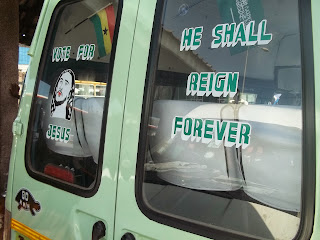This week's article will discuss who the driver and mate are, and their roles in the 'Trotro'.
 'Trotro' vehicles are operated by two men, that is, a driver and a 'mate'. The 'Trotro' driver's job is to drive the bus safely to its destination. If the 'Trotro' breaks down on the road, the 'Trotro' driver's first priority is to determine if the passengers safety or security is at stake.
'Trotro' vehicles are operated by two men, that is, a driver and a 'mate'. The 'Trotro' driver's job is to drive the bus safely to its destination. If the 'Trotro' breaks down on the road, the 'Trotro' driver's first priority is to determine if the passengers safety or security is at stake.The driver will assess the problem which resulted in the breakdown of the vehicle and may call for help from passengers to deal with the problem. In most cases, passengers will alight and 'push' the car whiles the driver will sit at the steer and start the car.

The mate collects fares from passengers, shout out of the window to get hold of new passengers. He is also responsible for seating passengers and helping passengers with loads to get on board the vehicle. He uses certain hand signals to show the destination of the vehicle.
To earn a little money for his pocket, the mate sometimes sells his seat to passengers, but most often, passengers do not feel comfortable and therefore complain and accuse him of selling his seat position and rather choosing to sit on the metallic cover of the engine adjoining the front seat.. The fare from the seat becomes unaccounted for. It belongs to him and the driver cannot ask for it.
Some mates have a good sense of humour and normally crack jokes to entertain passengers whiles others may also engage in words exchange with the passengers and when there is tension, the driver may intervene.




